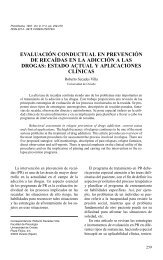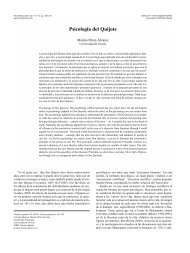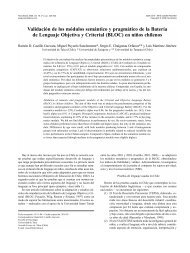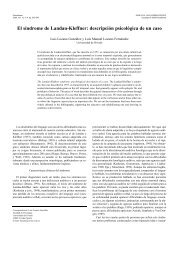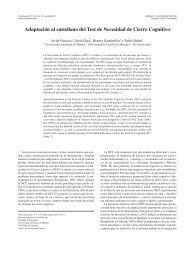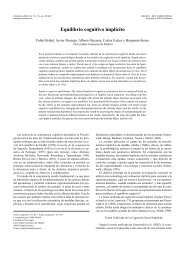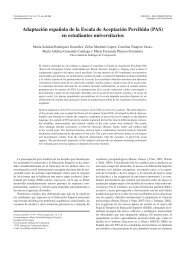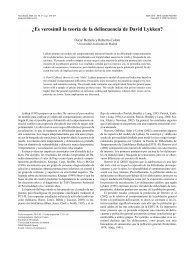WATOCI - Universidad de Oviedo
WATOCI - Universidad de Oviedo
WATOCI - Universidad de Oviedo
You also want an ePaper? Increase the reach of your titles
YUMPU automatically turns print PDFs into web optimized ePapers that Google loves.
Psicothema 2004. Vol. 16, nº 4, pp. 702-705 ISSN 0214 - 9915 CODEN PSOTEG<br />
www.psicothema.com Copyright © 2004 Psicothema<br />
Psychometric properties of the Spanish version of the Working Alliance<br />
Theory of Change Inventory (<strong>WATOCI</strong>)<br />
Psychotherapy could not be conceived without the existence of<br />
a client-therapist relationship. The therapeutic meeting between patient<br />
and practitioner plays an essential role in the psychotherapeutic<br />
process. Psychotherapy researchers rate the relative contribution<br />
of relationship factors as accounting for 30% of the total change<br />
that patients make (Lambert, 1992). Therapeutic alliance has been<br />
i<strong>de</strong>ntified as the main factor contributing to such psychotherapeutic<br />
relationship. Horvath and Greenberg (1994) explain that in the<br />
current notion of working alliance, «collaboration» between therapist<br />
and client is the key element. At its best, the working alliance<br />
provi<strong>de</strong>s a safe environment for clients to explore themselves and<br />
a relationship in which clients’ «key relational issues» are <strong>de</strong>fined.<br />
The role of therapeutic alliance in promoting and facilitating therapeutic<br />
change was initially highlighted by psychoanalytically oriented<br />
psychotherapists (for a review, see Bordin, 1994), but is<br />
nowadays acknowledged by most theoretical approaches. Bordin<br />
(1979) <strong>de</strong>fined the working alliance as consisting of three components:<br />
agreement on overall goals, agreement on tasks that lead towards<br />
achieving these goals, and emotional bond between the therapist<br />
and client.<br />
Thus, the construction and validation of scales and inventories<br />
<strong>de</strong>signed to assess key dimensions of effective therapeutic relationships<br />
has been one of the goals of psychotherapy researchers in re-<br />
Fecha recepción: 5-5-03 • Fecha aceptación: 20-5-04<br />
Correspon<strong>de</strong>ncia: Sergi Corbella<br />
FPCEE Blanquerna<br />
<strong>Universidad</strong> Ramón Llull<br />
08022 Barcelona (Spain)<br />
E-mail: sergics@blanquerna.url.es<br />
Sergi Corbella and Luis Botella<br />
FPCEE Blanquerna, <strong>Universidad</strong> Ramón Llull<br />
This Brief Report presents a study of the psychometric qualities of the Working Alliance Theory of<br />
Change Inventory (Spanish version). <strong>WATOCI</strong>’s reliability coefficient based on the internal consistency<br />
is good. Results seem to suggest (a) that the theoretical structure of the instrument should be<br />
further refined, and (b) that therapeutic alliance may be a more unified construct than is usually<br />
thought of. While it is theoretically possible to divi<strong>de</strong> it into different components, clinical research<br />
with psychotherapy patients seems to indicate that goals, tasks, bond and theory of change are closely<br />
related.<br />
Características psicométricas <strong>de</strong> la versión española <strong>de</strong>l inventario <strong>de</strong> la alianza terapéutica y teoría<br />
<strong>de</strong>l cambio. Este artículo presenta un estudio <strong>de</strong> las características psicométricas <strong>de</strong> la versión española<br />
<strong>de</strong>l Inventario <strong>de</strong> Alianza Terapéutica y Teoría <strong>de</strong>l Cambio (<strong>WATOCI</strong>). La estimación <strong>de</strong>l coeficiente<br />
<strong>de</strong> fiabilidad basada en la consistencia interna <strong>de</strong> la versión española <strong>de</strong>l <strong>WATOCI</strong> se <strong>de</strong>mostró buena.<br />
Los resultados parecen sugerir: (a) que la estructura teorica <strong>de</strong>l instrumento <strong>de</strong>be ser revisada y refinada<br />
a fondo, y (b) que la alianza terapéutica pue<strong>de</strong> ser un constructo más unificado. Teóricamente es<br />
posible diferenciar entre las subescalas <strong>de</strong> la alianza terapéutica, pero los datos indican que los ítems<br />
<strong>de</strong> las subescalas <strong>de</strong> objetivos, tareas, vínculo positivo y teoría <strong>de</strong>l cambio están muy asociados.<br />
cent <strong>de</strong>ca<strong>de</strong>s. One of these questionnaires is the Working Alliance<br />
Theory of Change Inventory (<strong>WATOCI</strong>; Duncan and Miller, 1999).<br />
The Working Alliance Inventory was <strong>de</strong>veloped by Horvath and<br />
Greenberg (1989). It is a self-report measure consisting of 36<br />
items and three subscales of 12 items each representing three dimensions<br />
of working alliance (Bond, Goals, Tasks). A counselor<br />
and a client form are used to collect information regarding the reported<br />
strength of the working alliance. Horvath and Greenberg<br />
(1986) reported internal consistency estimates with alphas of .93<br />
for the client total score and .87 for the therapist total score. The<br />
internal consistencies for the client sub-scales were reported as alphas<br />
of of .90, .88, and .91 for task, bond, and goal respectively. It<br />
was also found to have good convergent and divergent validity using<br />
a multitrait-multimethod analysis. The original 36-item WAI is<br />
also available in a short form version (WAI-S), comprised of 12<br />
items (Tracey and Kokotovic, 1989).<br />
The <strong>WATOCI</strong> is a 17-item pencil and paper version of the wellestablished<br />
Working Alliance Inventory (WAI). The WAI (short<br />
version, Tracey and Kokotovic, 1989) was <strong>de</strong>veloped and validated<br />
in relation to Bordin’s transtheoretical mo<strong>de</strong>l of alliance (Bordin,<br />
1994)—see Horvath and Greenberg (1986) for further information<br />
regarding the validation of the WAI. The shortened version<br />
of the WAI is a 12-item self-report measure that uses a 7-point<br />
Likert rating scale (1= never, 7= always) to yield both an overall<br />
score for alliance quality and three summed sub-scale scores (4<br />
items per each sub-scale in the WAI short version):<br />
(1) Bond: the emotional bond of trust and attachment between<br />
patient and therapist. Some of the facilitative conditions<br />
that help to create such a bond are: mutual un<strong>de</strong>rstanding
PSYCHOMETRIC PROPERTIES OF THE SPANISH VERSION OF THE WORKING ALLIANCE THEORY OF CHANGE INVENTORY (<strong>WATOCI</strong>) 703<br />
between patient and therapist, a caring attitu<strong>de</strong> on the therapist’s<br />
si<strong>de</strong>, and the patient’s perception that the therapist<br />
likes him or her.<br />
(2) Goals: the <strong>de</strong>gree of agreement concerning the overall<br />
goals of treatment. Thus, the client is aware that such goals<br />
are relevant and he or she i<strong>de</strong>ntifies him or herlself with<br />
the themes ma<strong>de</strong> explicit and implicit during the therapeutic<br />
process. The therapist has some direct or indirect evi<strong>de</strong>nce<br />
that the goals established in the therapeutic relationship<br />
are shared with and accepted by the client.<br />
(3) Tasks: the <strong>de</strong>gree of agreement concerning the tasks relevant<br />
for achieving these goals. Both therapist and client feel<br />
that the tasks agreed upon during the therapeutic process are<br />
rational, reachable, and closely related to the therapeutic<br />
goals (Horvath and Greenberg, 1986).<br />
Tracey and Kokotovic’s (1989) factor analysis of the WAI yiel<strong>de</strong>d<br />
an alliance overall main factor and three other factors that accounted<br />
for the three alliance sub-scales. The WAI-S (short version)<br />
<strong>de</strong>rived from this study and it yiel<strong>de</strong>d a Chronbach’s alpha of<br />
.94. In the same study, the internal consistency reliabilities were<br />
.90, .84 and .88 for task, bond and goal scores, respectively (Tracey<br />
and Kokotovic, 1989).<br />
Duncan and Miller (1999) ad<strong>de</strong>d 5 items <strong>de</strong>aling with the<br />
agreement between patient’s and therapist’s theory of change to<br />
the reduced version of the WAI. This brief report presents the psychometric<br />
properties of the Spanish version of the <strong>WATOCI</strong> (see<br />
Table 1).<br />
Method<br />
Research participants were 102 adults (79 women and 23 men)<br />
receiving outpatient psychotherapy. The mean age for the participants<br />
was 30.0 years (SD= 8.74). Their presenting complaints<br />
were: anxiety (41.7% of the sample); mood disor<strong>de</strong>rs (39.9%); and<br />
interpersonal/relational difficulties (17.5%). All of them completed<br />
the Spanish version of the <strong>WATOCI</strong> at the end of the third psychotherapy<br />
session.<br />
Results<br />
Instrument’s coefficient of reliability based on the internal consistency<br />
assessed by Cronbach’s Alpha is .93. The internal consistencies<br />
for the sub-scales were reported as alphas of .91, .85, .86,and<br />
.0,82 for task, bond, goal, and theory of change respectively.<br />
Kaiser-Meyer-Olkin Measure of Sampling A<strong>de</strong>quacy and<br />
Bartlett’s Test of Sphericity indicated that the factor mo<strong>de</strong>l was<br />
appropiate. We also performed an exploratory Principal Component<br />
Analysis (with Varimax rotation), and it extracted three factors<br />
(eigenvalues over 1) with eigenvalues of 5.66 (first factor);<br />
2.81 (second factor); and 2.59 (third factor). The three factors account<br />
for 65% of the total variance.<br />
As can be seen in Table 2, the first factor is ma<strong>de</strong> up by a combination<br />
of (a) all items belonging to the tasks sub-scale; (b) two<br />
items belonging to the goals sub-scale, and (c) four items belonging<br />
to the theory of change sub-scale. The second factor is ma<strong>de</strong> up by<br />
a combination of (a) two items belonging to the goals sub-scale, and<br />
(b) one item belonging to the theory of change sub-scale. The third<br />
factor is ma<strong>de</strong> up by three of the four items belonging to the bond<br />
sub-scale. Thus, the first factor is ma<strong>de</strong> up of items belonging to all<br />
subscales, the second one is ma<strong>de</strong> up of some items belonging to the<br />
goals subscale and one belonging to the theory of change subscale,<br />
and the third one is ma<strong>de</strong> up of items belonging to the bond subscale.<br />
Thus, it seems that the tasks, goals, theory of change subscales,<br />
and one item belonging to the bond subscale account for the first<br />
two factors, whereas three of the four items belonging to the bond<br />
subscale account for the third factor.<br />
Discussion<br />
The internal consistency reliabilities for the total score, and<br />
subscales were good and agree with Tracey and Kokotovic’s results<br />
(Tracey and Kokotovic, 1989).<br />
A closer look at the Principal Component Analysis results reveals<br />
that the Spanish version of the <strong>WATOCI</strong> does not fit well<br />
with the structure that could be expected from Bordin’s (1994) theory<br />
of therapeutic alliance. Factors obtained in the analysis do not<br />
discriminate between items belonging to different subscales; items<br />
from all subscales are attributed to the first factor, items from two<br />
different subscales are attributed to the second one, whereas some<br />
items in the bond subscale are attributed to the third factor.<br />
These results seem to suggest (a) that the la theoretical structure<br />
of the instrument should be further refined, and (b) that therapeutic<br />
alliance may be a more unified construct than is usually<br />
thought of. While it is theoretically possible to divi<strong>de</strong> it into different<br />
components, clinical research with psychotherapy patients<br />
seems to indicate that goals, tasks, bond and theory of change are<br />
closely related and are not orthogonal factors.<br />
Thus, the results of this study are partially in agreement with<br />
those of the one by Tracey and Kokotovic (1989) mentioned before<br />
n which they reported finding a first factor ma<strong>de</strong> up of items<br />
belonging to all subscales. Our own results validate the notion that<br />
therapeutic alliance as assessed by the <strong>WATOCI</strong> is a coherent construct,<br />
but they also cast some doubts on the supposedly threefold<br />
structure of such a construct. Also, Duncan and Miller’s (1999)<br />
addition of the «theory of change» sub-scale does not add any<br />
meaningful clarification to the structure of the previous WAI short<br />
version.<br />
Acknowledgements<br />
This work was carried out while Sergi Corbella was hol<strong>de</strong>r of<br />
a Grant awar<strong>de</strong>d by the Spanish Ministry of Education and Culture<br />
(AP 98).
704<br />
Cliente:<br />
Terapeuta:<br />
Sesión nº:<br />
Fecha <strong>de</strong> la sesión:<br />
SERGI CORBELLA AND LUIS BOTELLA<br />
Table 1<br />
Spanish <strong>WATOCI</strong><br />
Inventario <strong>de</strong> Alianza Terapéutica y Teoría <strong>de</strong>l Cambio (<strong>WATOCI</strong>)<br />
(C) 1999 Barry Duncan and Scott D. Miller<br />
Por favor, evalúe la sesión <strong>de</strong> hoy según estas afirmaciones. Ro<strong>de</strong>e con un círculo la puntuación que mejor <strong>de</strong>scriba su opinión usando el sistema siguiente:<br />
Nunca Muy pocas veces En ocasiones Punto medio Bastante a menudo Casi siempre Siempre<br />
1 2 3 4 5 6 7<br />
01. Mi terapeuta y yo estamos <strong>de</strong> acuerdo en lo que hay que hacer para contribuir a mejorar mi situación.<br />
1 2 3 4 5 6 7<br />
02. Lo que hago en terapia me permite ver nuevas formas <strong>de</strong> consi<strong>de</strong>rar mi problema.<br />
1 2 3 4 5 6 7<br />
03. Caigo bien a mi terapeuta.<br />
1 2 3 4 5 6 7<br />
04. Mi terapeuta y yo tenemos i<strong>de</strong>as diferentes sobre lo que intento conseguir en la terapia.<br />
1 2 3 4 5 6 7<br />
05. Confío en la capacidad <strong>de</strong> mi terapeuta para ayudarme.<br />
1 2 3 4 5 6 7<br />
06. Mi terapeuta y yo estamos trabajando con metas que hemos acordado ambos.<br />
1 2 3 4 5 6 7<br />
07. Siento que mi terapeuta me aprecia.<br />
1 2 3 4 5 6 7<br />
08. Mi terapeuta y yo estamos <strong>de</strong> acuerdo en cuáles son las cosas importantes en que <strong>de</strong>bería trabajar en la terapia.<br />
1 2 3 4 5 6 7<br />
09. Mi terapeuta y yo confiamos el uno en el otro.<br />
1 2 3 4 5 6 7<br />
10. Mi terapeuta y yo tenemos i<strong>de</strong>as diferentes respecto a cuáles son mis problemas.<br />
1 2 3 4 5 6 7<br />
11. Mi terapeuta y yo hemos llegado a una buena comprensión <strong>de</strong>l tipo <strong>de</strong> cambios que serían buenos para mí.<br />
1 2 3 4 5 6 7<br />
12. Creo que la forma en que estamos trabajando con mi problema es la correcta.<br />
1 2 3 4 5 6 7<br />
13. Mi terapeuta y yo coincidimos en cuanto a mis metas en la terapia.<br />
1 2 3 4 5 6 7<br />
14. Creo que lo que mi terapeuta y yo hacemos en terapia es irrelevante para mis preocupaciones.<br />
1 2 3 4 5 6 7<br />
15. Creo que las cosas que hago en terapia me ayudarán a conseguir los cambios que <strong>de</strong>seo.<br />
1 2 3 4 5 6 7<br />
16. Las cosas que mi terapeuta me pi<strong>de</strong> que haga son intrascen<strong>de</strong>ntes o incomprensibles para mí.<br />
1 2 3 4 5 6 7<br />
17. Las sesiones se centran en mis i<strong>de</strong>as sobre lo que ha <strong>de</strong> pasar para que se produzca un cambio.<br />
1 2 3 4 5 6 7
PSYCHOMETRIC PROPERTIES OF THE SPANISH VERSION OF THE WORKING ALLIANCE THEORY OF CHANGE INVENTORY (<strong>WATOCI</strong>) 705<br />
Table 2<br />
Principal component analysis of the Spanish <strong>WATOCI</strong> results (rotation method:<br />
varimax with Kaiser normalization)<br />
Components<br />
Item number Sub-scale 1 2 3<br />
Factor Loadings<br />
01 Tasks .80 .33<br />
02 Tasks .51 .38 .41<br />
03 Bond .23 .26 .85<br />
04 Goals .37 .65<br />
05 Bond .71 .32 .26<br />
06 Goals .63 .26 .36<br />
07 Bond .32 .23 .83<br />
08 Tasks .78 .25 .15<br />
09 Bond .59 .15 .50<br />
10 Goals .42 .53 .14<br />
11 Goals .69 .32<br />
12 Tasks .75 .32 .30<br />
13 Theory of Change .72 .38<br />
14 Theory of Change .76 .30<br />
15 Theory of Change .64 .39 .31<br />
16 Theory of Change .24 .73 .25<br />
17 Theory of Change .60 -.25 .25<br />
Note: Values less than .1 have been omitted.<br />
Bordin, E.S. (1979). The generalizability of the psychoanalytic concept of<br />
the working alliance. Psychotherapy: Theory, research, and practice,<br />
16, 252-260.<br />
Bordin, E.S. (1994). Theory and research therapeutic working alliance:<br />
New Directions. In A. O. Horvath and L. S. Greenberg (Eds.), The<br />
Working Alliance. Theory, Research, and Practice (pp. 13-37). New<br />
York: Wiley.<br />
Duncan, B.L. and Miller, S.D. (1999). Working Alliance Theory of Change<br />
Inventory (<strong>WATOCI</strong>). Retrieved November, 20, 1999, from The Institute<br />
for the Study of Therapeutic Change (ISTC) Web site:<br />
http://www.talkingcure.com/<br />
References<br />
Horvath, A.O. and Greenberg, L.S. (1986). The <strong>de</strong>velopment of the working<br />
alliance inventory. In L.S. Greenberg and W.M. Pinsoff (Eds.), The<br />
Psychotherapeutic Process: A Research Handbook (pp. 529-556). New<br />
York: Guilford Press.<br />
Lambert, M.J. (1992). Implications of psychotherapy outcome research for<br />
eclectic and integrative psychotherapies. In J.C. Norcross and M.V.<br />
Goldfried (Eds.), Handbook of Psychotherapy Integration. New York:<br />
Basic Books.<br />
Tracey, T. J. and Kokotovic, A.M. (1989). Factor structure of the Working<br />
Alliance Inventory. Psychological Assessment, 1, 207-210.



